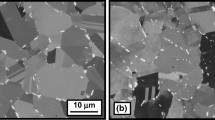Abstract
The springback and anelastic behavior of selected Mg alloys were investigated as a function of thermo-mechanical state and loading conditions by strain-recovery experiments in three-point bending. The observed stress relaxations were primarily due to recoverable microstructural relaxations and the transformation of linear-elastic strains to recoverable time-dependent anelastic strains. This transformation occurs by thermally activated dislocation motion or reversible twin movement and influences the magnitude of the springback effect. The amount of anelastic strain observed during stress relaxation experiments was found to depend on four factors: initial dislocation density (cold work), applied strain levels, temperature, and holding time at fixed strain levels.














Similar content being viewed by others
References
Aghion E and Eliezer D (eds) (1997) Magnesium 1997-The First International Conference on Magnesium Science & Technology, The Dead Sea
Aghion E and Eliezer D (eds) (2000) Magnesium 2000-The Second International Conference on Magnesium Science & Technology, The Dead Sea
Wilson D, Metalworking Production, Automotive 2003
Caceres CH, Sumitomo T, Veidt M (2003) Acta Mater 51:6211
Standard Practice for Determining and Reporting the Dynamic Mechanical Properties of Plastics (1995) ASTM Intl., vol. ASTM D4065-95
Dieter GE (1976) Mechanical metallurgy. McGraw-Hill, New York
Nowick AS, Berry BS (1972) Anelastic relaxation in crystalline solids. Academic Press, New York
Zener C (1948) Elasticity and anelasticity of metals. Univ. of Chicago, Illinois
Gibeling JC, Nix WD (1981) Acta Metallurgica 29:1764
Nir N, Hart EW, Li CY (1976) Scripta Metallurgica 10:189
Morestin F, Boivin M (1996) Nucl Eng Design 162:107
Cleveland RM, Ghosh AK (2002) Intern J Plast 18:765
Yin DL, Wang JT, Liu JQ, Zhao X (2009) In: Agnew R, Neelameggham NR, Pekgulery MO, Nyberg EA (eds) TMS 2009. Magnesium Technology, Sun Francisco, p 235
Yin DL, Wang JT, Liu JQ, Zhao X (2009) In: Agnew R, Neelameggham NR, Pekgulery MO, Nyberg EA (eds) TMS 2009. Magnesium Technology, Sun Francisco, p 357
Reed-Hill RE, Dahlberg EP, Slippy WA Jr (1965) AIME Trans 233:1766
Gharghouri MA, Weatherly GC, Embury JD, Root J (1999) Phil Mag A 79:1671
Stevens N (1981) Metal handbook, vol 4, 9th edn. American Society for Metals, Materials Park, p 744
Author information
Authors and Affiliations
Corresponding author
Rights and permissions
About this article
Cite this article
Munitz, A., Kaufman, M.J. Springback and anelasticity of mg alloys measured in three-point bending. J Mater Sci 48, 5361–5372 (2013). https://doi.org/10.1007/s10853-013-7331-8
Received:
Accepted:
Published:
Issue Date:
DOI: https://doi.org/10.1007/s10853-013-7331-8




